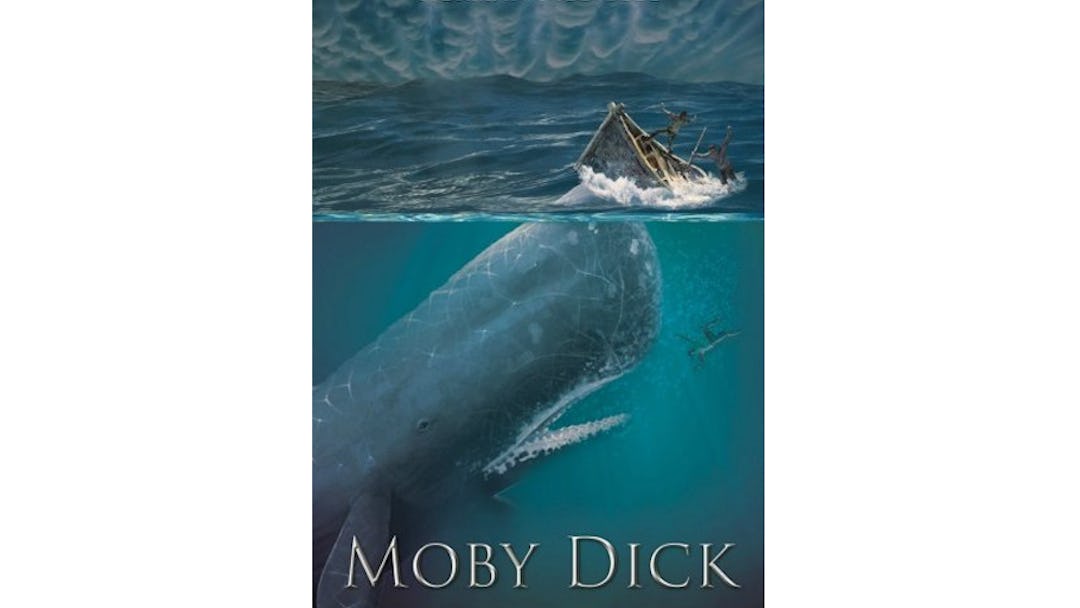Moby-Dick; or, The Whale, by Herman Melville was published in 1851. In fact, today, November 14, marks the 163rd anniversary of the novel’s first U.S. printing. It was not a blockbuster at first glance; in fact, it was out of print by the time that Melville passed away in 1891, with only about 3200 copies sold during his lifetime. It was, by any account, a literary failure.
It’s a comforting story, even. After all, who could read a book that involved hundreds of pages of whale arcana, along with a ripping good story about men on a boat, hunting the ultimate obsession, the white whale? Who could fall into the weird, completely new way that Melville structured the book, so that it’s drama, theater, tragedy, comedy, everything the Greeks wrote about and everything that Shakespeare and The Bible made into heightened language, into Scripture?
But then time took its toll — Moby-Dick was reprinted after Melville’s death, along with the rest of his books. After World War I, writers like Carl Van Doren and D.H. Lawrence argued for the whale’s genius, and the 1941 publication of F. O. Matthiessen’s American Renaissance: Art and Expression in the Age of Emerson and Whitman placed Melville on a spectrum of literature with our Transcendentalists.
From an inauspicious beginning, Moby-Dick had pulled off the impossible: it started to matter. And it stayed in print, inspiring adaptations in film and onscreen. (There is even a Moby-Dick opera.) Nowadays, it’s referred to as the “American Bible,” and its use of language has permeated our everyday usage — after all, we all have a white whale, don’t we? Writers like Nathaniel Philbrick, the author of the National Book Award winning In the Heart of the Sea: The Tragedy of the Whaleship Essex (due to beand Why Read Moby-Dick? among other books, see the book as a survival manual. “I think one of the reasons that its lasted is because Melville describes a community with a leader headed towards obvious tragedy,” Philbrick said on the phone. “It’s a story about what do you in the face of impending disaster?” Melville wrote it in the face of the looming Civil War, and that perspective has remained ever significant. “We’re always on the edge of an impending catastrophe.”
For Amanda Bullock, the Director of Programming at Housing Works Bookstore Cafe in New York City, and one of the cofounders and co-organizers of the NYC Moby-Dick Marathon — which kicks off its three-day celebration of Dick tonight at the Ace Hotel — the book can “be mapped onto any time, it’s eternally relevant, with issues like the current oil crisis or our problems with the climate and environment.”
While it may be a hefty tome, it also features a surprising amount of humor and modernity that makes it a good read. “It’s also a book that’s very of its time,” Bullock pointed out. The book gives you all the knowledge you need about the whaling industry in 1851, with the arcane mistakes that we had made about the sea creature. “He insists that whales are fish,” she said.
At WORD Bookstore in Greenpoint, Moby-Dick is a perennial purchase. “It comes up,” said Jaye Bartell, the event coordinator for the store. “It’s a point of passage in reading in American literature.” But according to the bookseller, Moby-Dick is in that category of books that people are like, man, I should read this — which includes a lot of purchases of David Foster Wallace’s Infinite Jest and Roberto Bolano’s 2066. “People are a little more excited about Game of Thrones, but they shouldn’t be intimated.” Bartell came to Moby-Dick because he’s a New England native, and it kept getting referenced in things he was reading, like poet Charles Olson’s Call Me Ishmael. He was struck by the beauty of the writing, and the incredible strangeness of the structure, the way that the book starts with a glossary of terms so that you know exactly what Melville’s talking about when Ishmael takes to the sea.
Perhaps what Moby-Dick has to offer for generations of readers is “a shaft of light in the darkness,” as Philbrick puts it. “Not that it provides any real consolation, it just resonates with what it means to be alive in the face of terrifying change.” Change is one of the things we’re constantly facing in life, and maybe with Melville’s masterpiece, we get a chance to see what it’s like to survive this thing called life — madness, obsession, and one giant white whale.
The second Moby-Dick Marathon NYC runs from Friday, November 14- Sunday, November 16 at the Ace Hotel, the South Street Seaport Museum, and Housing Works Bookstore. Nathaniel Philbrick will be reading at 4pm on Saturday. There are also Moby-Dick Marathons in Massachusetts planned for January, in New Bedford and on Nantucket Island. Illustration from Matt Kish‘s epic Every Page of Moby Dick.
